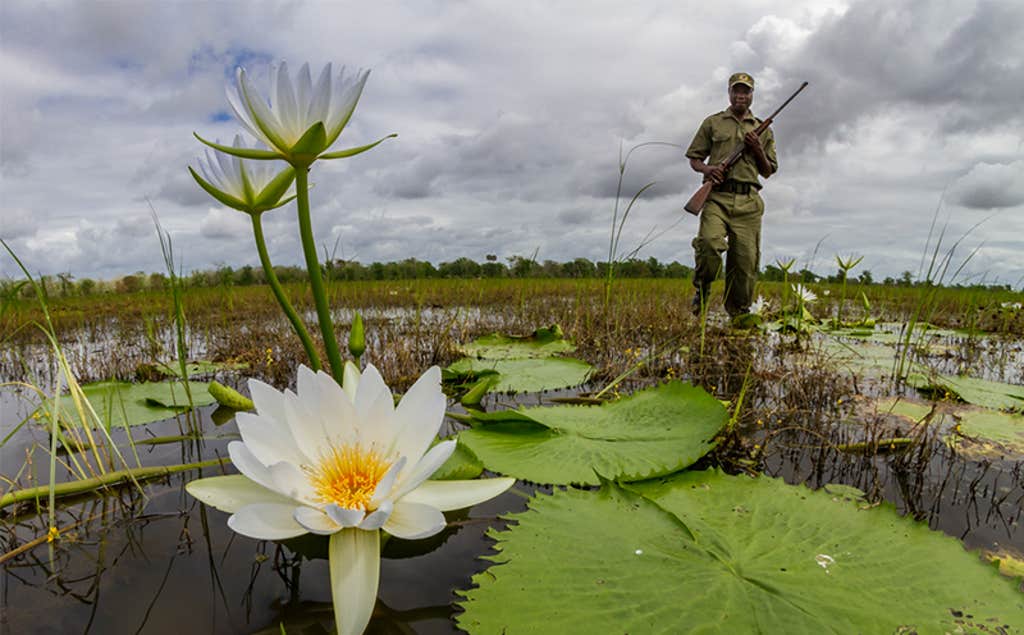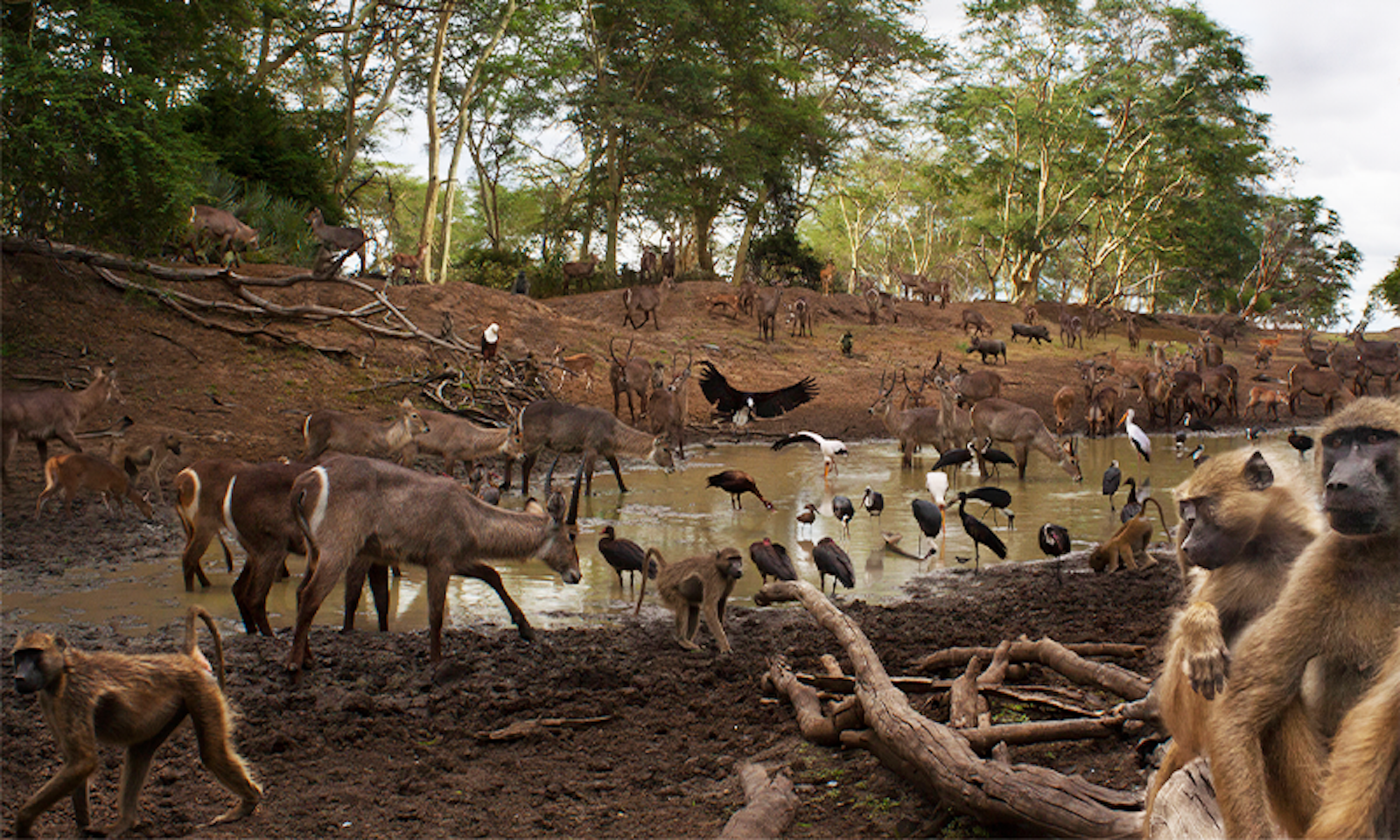
The maximalism of the landscape dumbfounds me. The floodplain is electric green, the grasses a startling amber. Minutes after Erin Phillips drives our safari truck away from Chitengo Camp, the main lodge in Gorongosa National Park, there’s an immediate bounty of animals around us—bushbuck bounce beside the vehicle, wildebeest kick their gangly legs in the dust. “That’s so Lion King,” Phillips murmurs from behind the wheel. It almost feels as if we are driving through a living nature documentary.
This abundance is a far cry from the decimation the landscape endured during Mozambique’s 15-year civil war, from 1977 to 1992, when poaching and starvation wiped out more than 90 percent of large herbivores, such as antelope and elephant, and apex predators. And it may hold the answers to future recoveries.
Bushbuck bounce beside our truck, wildebeest kick their gangly legs. “That’s so Lion King.”
Phillips, a graduate student at Princeton University, studies mesocarnivores—mid-sized meat eaters—which seem to have an especially high density in Gorongosa. After the civil war ravaged the country, there were only about 20 lions estimated in the 1 million-acre park. There were no African wild dogs, no hyenas. When you take away the large predators, the little ones flourish, Phillips explains. “Smaller things really popped off.”
Her focus in Gorongosa is the African civet—a mostly nocturnal, striped-and-spotted animal the size of a housecat that is relatively understudied—collecting fecal samples for diet analysis and using traps to collar the viverrids and take photos and videos when a sensor detects motion. She has been studying civets here over time as the park reintroduces top predators, to understand how they fare as large cats arrive, and how the two kinds of animals interact with each other.

By studying across the ecological system—from plants to fire to herbivore niches to predator-prey dynamics—scholars like Phillips use Gorongosa as a living lab to understand the fundamental principles of ecology and rules of ecosystem restoration. This knowledge, specific to Gorongosa, is invaluable to study of restoration worldwide. And the civets can help scientists understand how the overall ecosystem is changing now that larger carnivores are slowly returning to the park.
Phillips’ work is part of a decades-long scientific project to understand on a detailed level how an ecosystem returns from a collapse. Here, scientists peer beneath the surface of how ecology works, studying the interplay among plant and animal species, down to the behavior of their genes.
“There’s a lot of research in ecology that really zooms out and tries to take a global, continental, or global scale perspective,” says Rob Pringle, a Princeton biologist who has been studying various aspects of the park for the past 13 years. “But I’m a big believer in understanding the importance of understanding mechanisms and cause-effect relationships. And I think you can’t really do that in many places simultaneously.”

The studies of Gorongosa’s recovery involve experts from across the globe. Princeton alone sent 10 researchers—from undergraduates to Pringle, the group’s principal investigator—for the summer, with a head-spinning schedule of checking traps, collecting feces, and darting and collaring animals. During my visit in June, the camp often felt like a science convention, with researchers pondering questions about specific species over cups of local coffee and rolls. Other scholars from the United Kingdom, Germany, and South Africa found Gorongosa as a productive spot to research ant-termite interactions, how mosquitoes respond to light, and how carbon is stored in the swampy floodplains.
Hallie Walker Brown, a Princeton postdoctoral researcher, meets me after hopping off the helicopter that Pringle has rented for the summer’s fieldwork season. She is working to attach collars to antelope to understand the biology and physiology of fear. Heart rate sensors will also allow her to track their beats per minute and study how gene regulation and heart rates change when shy or bold individuals are frightened. Gorongosa is running a natural experiment of adding predators, she says, which allows scientists to test in real time whether animals are innately more bold or shy, or whether they are just shifting their behaviors to mitigate the effect of a new fear element on the landscape.
Erin Phillips slams on the brakes, slides from the wheel, and crouches beside a latrine of civet scat.
Her study is comparing bushbuck behavior, physiology, and genetics at the core of the park, where the wild dogs were reintroduced in 2019, to two other similarly sized areas in the north, where the predators haven’t quite arrived yet—allowing her to compare the groups. The research is part of a new field of behavioral genomics—the effects of multiple genes on behaviors—and it has been studied in mice, insects, fish, and now, of course, the antelope she’s studying.
Pringle, who first came to Gorongosa in 2010, while he was a fellow at Harvard University, and who has studied the area deeply as species were reintroduced and numbers of herbivores grew, remembers that as the antelope flourished without large predators around, they developed uncommon behaviors—grazing in the middle of floodplains where they would have formerly been at risk of predation. In one 2019 study, Pringle played sounds of leopards and laid down the scent of carnivores, and found that bushbucks headed back toward trees when they sensed predators nearby.
The balance of species is still a little unusual for what scientists would have expected from a recovering savannah: Gorongosa has more waterbuck, but fewer rhinos and hippos than other places similar in geography and size. Pringle is interested in how animals are using the habitat and how their behaviors and fitness change now that carnivores are coming back.

Collaborators at the park are also using DNA meta barcoding, which allows scientists to collect fecal samples and sequence it to look at multiple taxa: the DNA of gut bacteria, worms, leftover animal parts, and other sundries. Excrement can be a rich source of information, including helping figure out which species is related to which—which correlates to another field of study in the park that is putting together a Map of Life to describe inter-species relationships. It also offers a noninvasive approach to figure out the population of a particular species that’s far less expensive than helicopter-based surveys.
The new tech tools might be able to answer Gorongosa-specific questions. For example, zebras have not recovered in the park in the way that biologists had anticipated. Everything about zebras says they should be doing great, Pringle says: There is an abundance of grass and relatively few predators. But their population is kind of stuck—18 zebras survived the war, and 15 more were added from a nearby hunting preserve over 2013 and 2014, but their population never took off as expected, and it’s not clear why. The last aerial count showed there were only 41. (Zebras usually reproduce every two or three years.) Pringle’s group is now studying this population through collars and genomic tools to help gain insight into why the species isn’t recovering. Are they inbred? Are they overly stressed? Or is something more subtle happening to prevent their population from growing?

Most national parks have tiny lab stations, but the biology lab at Gorongosa is a modern marvel. I step into the space—which the park estimates is the most advanced biological lab in Mozambique—to see Katie Solari unpacking scientific equipment she’s brought from Stanford University, including reagents that had to be kept cold during an unexpected delay in Frankfurt. “We had to use a lot of extra ice packs,” she says. Solari is a postdoctoral researcher in the lab of evolutionary biologist Dmitri Petrov, where they study rapid evolution, adaptation, and genomics. In forming collaborations with labs like Petrov’s, Pringle says his group is trying to push the edge of research that is currently possible, advancing the science of molecular biology through partnership with ecology.
This is Petrov’s first year in Gorongosa, but he has a five-year grant to explore genetics in the park—hopefully adapting user-friendly tools that won’t require samples to be taken out of Mozambique to be analyzed and interpreted. Next summer, he hopes to bring a DNA sequencer. As the prices for sampling drop, he says, the amount of questions that can be answered using genetics increases exponentially. And, he says, genetic technology should be used more in conservation. The tools can be used to track reproductive success; to understand diet, stress, and parasite load; to draw a direct link between ecology and fitness.
When you look at genetic data from around Africa, there’s a “gigantic hole when it comes to Mozambique,” Solari says—largely due to the many years of conflict—so even the most basic information can be hugely useful. Some of the genetic data scientists collect in Gorongosa this summer may be able to answer whether floodplain and savannah bushbuck are the same species. Other antelope species such as kudu, nyala, impala, might be hybridizing, so there are basic questions about how many species exist in the park.
Much of that inquiry starts on the ground. As we drive through the park, Phillips slams on the brakes, slides from the wheel, and crouches beside a latrine of civet scat. Civets like to empty their bowels in a communal spot, and one of the loads is fresh and moist. Gently nudging open the clumps with a gloved finger, Phillips points out the beetle carcasses, bits of fruit, and seeds inside the excrement. She scoops some of the material into a zippered bag, to return to the lab for genetic analysis. By running scat samples through genetic testing and combining that with information from collars and blood samples, scientists will be able to better understand how the whole system recovers—and how to best manage the landscape in a rapidly changing world. From its own tragedy, Gorongosa may end up contributing an outsized amount of information to the world. ![]()
Katharine Gammon is a freelance science writer based in Santa Monica, California, who writes about environment, science, and parenting. You can find her on Twitter @kategammon.
Piotr Naskrecki is an entomologist, photographer, and author, currently at the Museum of Comparative Zoology, Harvard University. He is an associate director of the E.O. Wilson Lab at Gorongosa National Park.
Lead photo: A composite photo showing every animal that visited in one day one of the last remaining watering holes during the dry season in Gorongosa National Park, Mozambique.
The Nautilus Gorongosa Series is published in partnership with the Howard Hughes Medical Institute’s Science and Educational Media Group.




























